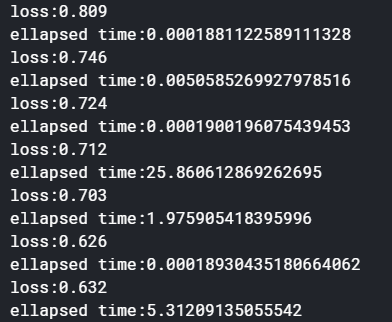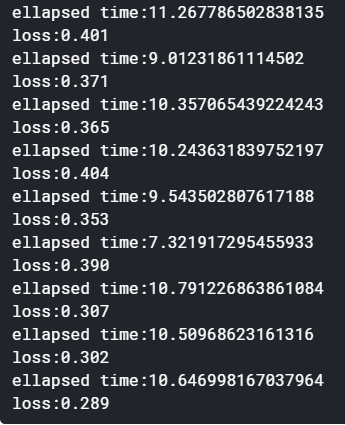Hi, I’m new to CV, here is my code:
# !/usr/bin/python
# -*- coding: utf-8 -*-
import cv2
import matplotlib.pyplot as plt
from os.path import isfile
import torch.nn.init as init
import torch
import torch.nn as nn
import numpy as np
import pandas as pd
import os
from PIL import Image, ImageFilter
from sklearn.model_selection import train_test_split, StratifiedKFold, KFold
from torch.utils.data import Dataset
from torchvision import transforms
from torch.optim import Adam, SGD, RMSprop, lr_scheduler
import time
from torch.autograd import Variable
import torch.functional as F
from tqdm import tqdm
from sklearn import metrics
import urllib
import pickle
import torch.nn.functional as F
from torchvision import models
import scipy as sp
from functools import partial
import random
import sys
from efficientnet_pytorch import EfficientNet
try:
from apex.parallel import DistributedDataParallel as DDP
from apex.fp16_utils import *
from apex import amp, optimizers
from apex.multi_tensor_apply import multi_tensor_applier
except ImportError:
raise ImportError("Please install apex from https://www.github.com/nvidia/apex to run this example.")
def seed_everything(seed):
random.seed(seed)
os.environ['PYTHONHASHSEED'] = str(seed)
np.random.seed(seed)
torch.manual_seed(seed)
torch.cuda.manual_seed(seed)
torch.backends.cudnn.deterministic = True
SEED = 1234
TTA = 5
num_classes = 1
IMG_SIZE = 256
DEBUG = True
n_epochs = 100
es = 3
AMP = 'O2'
device = torch.device("cuda")
seed_everything(SEED)
class OptimizedRounder(object):
def __init__(self):
self.coef_ = 0
def _kappa_loss(self, coef, X, y):
X_p = np.copy(X)
for i, pred in enumerate(X_p):
if pred < coef[0]:
X_p[i] = 0
elif pred >= coef[0] and pred < coef[1]:
X_p[i] = 1
elif pred >= coef[1] and pred < coef[2]:
X_p[i] = 2
elif pred >= coef[2] and pred < coef[3]:
X_p[i] = 3
else:
X_p[i] = 4
ll = metrics.cohen_kappa_score(y, X_p, weights='quadratic')
return -ll
def fit(self, X, y):
loss_partial = partial(self._kappa_loss, X=X, y=y)
initial_coef = [0.5, 1.5, 2.5, 3.5]
self.coef_ = sp.optimize.minimize(loss_partial, initial_coef, method='nelder-mead')
print(-loss_partial(self.coef_['x']))
def predict(self, X, coef):
X_p = np.copy(X)
for i, pred in enumerate(X_p):
if pred < coef[0]:
X_p[i] = 0
elif pred >= coef[0] and pred < coef[1]:
X_p[i] = 1
elif pred >= coef[1] and pred < coef[2]:
X_p[i] = 2
elif pred >= coef[2] and pred < coef[3]:
X_p[i] = 3
else:
X_p[i] = 4
return X_p
def coefficients(self):
return self.coef_['x']
def score(valid_predictions, test_predictions, targets):
optR = OptimizedRounder()
optR.fit(valid_predictions, targets)
coefficients = optR.coefficients()
valid_predictions = optR.predict(valid_predictions, coefficients)
test_predictions = optR.predict(test_predictions, coefficients)
cv_socre = metrics.cohen_kappa_score(targets, valid_predictions, weights='quadratic')
return valid_predictions, test_predictions, cv_socre
def expand_path(p):
p = str(p)
# print(train + p + ".png")
if isfile(train + p + ".png"):
return train + (p + ".png")
# if isfile(train_2015 + p + '.png'):
# return train_2015 + (p + ".png")
if isfile(test + p + ".png"):
return test + (p + ".png")
return p
def crop_image1(img, tol=7):
# img is image data
# tol is tolerance
mask = img > tol
return img[np.ix_(mask.any(1), mask.any(0))]
def crop_image_from_gray(img, tol=7):
if img.ndim == 2:
mask = img > tol
return img[np.ix_(mask.any(1), mask.any(0))]
elif img.ndim == 3:
gray_img = cv2.cvtColor(img, cv2.COLOR_RGB2GRAY)
mask = gray_img > tol
check_shape = img[:, :, 0][np.ix_(mask.any(1), mask.any(0))].shape[0]
if check_shape == 0: # image is too dark so that we crop out everything,
return img # return original image
else:
img1 = img[:, :, 0][np.ix_(mask.any(1), mask.any(0))]
img2 = img[:, :, 1][np.ix_(mask.any(1), mask.any(0))]
img3 = img[:, :, 2][np.ix_(mask.any(1), mask.any(0))]
# print(img1.shape,img2.shape,img3.shape)
img = np.stack([img1, img2, img3], axis=-1)
# print(img.shape)
return img
class MyDataset(Dataset):
def __init__(self, dataframe, transform=None):
self.df = dataframe
self.transform = transform
def __len__(self):
return len(self.df)
def __getitem__(self, idx):
label = self.df.diagnosis.values[idx]
label = np.expand_dims(label, -1)
p = self.df.id_code.values[idx]
p_path = expand_path(p)
image = cv2.imread(p_path)
image = cv2.cvtColor(image, cv2.COLOR_BGR2RGB)
image = crop_image_from_gray(image)
image = cv2.resize(image, (IMG_SIZE, IMG_SIZE))
image = cv2.addWeighted(image, 4, cv2.GaussianBlur(image, (0, 0), 30), -4, 128)
image = transforms.ToPILImage()(image)
if self.transform:
image = self.transform(image)
return image, label
def train_model(data_loader):
model.train()
avg_loss = 0.
optimizer.zero_grad()
for idx, (imgs, labels) in enumerate(data_loader):
imgs_train, labels_train = imgs.cuda(), labels.float().cuda()
output_train = model(imgs_train)
loss = criterion(output_train, labels_train)
with amp.scale_loss(loss, optimizer) as scaled_loss:
scaled_loss.backward()
optimizer.step()
optimizer.zero_grad()
avg_loss += loss.item() / len(data_loader)
return avg_loss
def val_model(data_loader):
avg_val_loss = 0.
model.eval()
with torch.no_grad():
for idx, (imgs, labels) in enumerate(data_loader):
imgs_vaild, labels_vaild = imgs.cuda(), labels.float().cuda()
output_test = model(imgs_vaild)
avg_val_loss += criterion(output_test, labels_vaild).item() / len(data_loader)
return avg_val_loss, output_test
def test_model(data_loader):
test_pred = np.zeros((len(data_loader), 1))
model.eval()
for _ in range(TTA):
with torch.no_grad():
for i, data in tqdm(enumerate(data_loader)):
images, _ = data
images = images.cuda()
pred = model(images)
test_pred[i * data_loader.batch_size:(i + 1) * data_loader.batch_size] += pred.detach().cpu().squeeze().numpy().reshape(-1, 1)
output = test_pred / TTA
return output
train_transform = transforms.Compose([
transforms.RandomHorizontalFlip(),
transforms.RandomRotation((-120, 120)),
transforms.ToTensor(),
transforms.Normalize([0.485, 0.456, 0.406], [0.229, 0.224, 0.225])])
train = '../input/train_images/'
test = '../input/test_images/'
train_csv = pd.read_csv('../input/train.csv')
test_csv = pd.read_csv('../input/test.csv')
test_transform = transforms.Compose([
transforms.RandomHorizontalFlip(),
transforms.RandomRotation((-120, 120)),
transforms.ToTensor(),
transforms.Normalize([0.485, 0.456, 0.406], [0.229, 0.224, 0.225])])
testset = MyDataset(test_csv,
transform=test_transform)
test_loader = torch.utils.data.DataLoader(testset, batch_size=64, shuffle=False)
folds = StratifiedKFold(n_splits=5, random_state=SEED)
y_valid_pred = np.zeros((train_csv.shape[0], 1))
y_test_pred = np.zeros((test_csv.shape[0], 1))
for n_fold, (trn_idx, val_idx) in enumerate(folds.split(train_csv, train_csv.diagnosis)):
print('fold {}:'.format(n_fold))
train_df, valid_df = train_csv.iloc[trn_idx], train_csv.iloc[val_idx]
if DEBUG:
train_df = train_df[:40]
valid_df = valid_df[:40]
# train_df, val_df = train_test_split(train_csv, test_size=0.1, random_state=2018, stratify=train_csv.diagnosis)
# train_df.reset_index(drop=True, inplace=True)
# val_df.reset_index(drop=True, inplace=True)
trainset = MyDataset(train_df, transform=train_transform)
train_loader = torch.utils.data.DataLoader(trainset, batch_size=32, shuffle=True, num_workers=4)
valset = MyDataset(valid_df, transform=train_transform)
val_loader = torch.utils.data.DataLoader(valset, batch_size=32, shuffle=False, num_workers=4)
model = EfficientNet.from_name('efficientnet-b5')
model.load_state_dict(torch.load('../../download/efficientnet-b5-586e6cc6.pth'))
in_features = model._fc.in_features
model._fc = nn.Linear(in_features, num_classes)
model.cuda()
optimizer = torch.optim.Adam(model.parameters(), lr=1e-3, weight_decay=1e-5)
criterion = nn.MSELoss()
scheduler = torch.optim.lr_scheduler.StepLR(optimizer, step_size=5, gamma=0.1)
model, optimizer = amp.initialize(model, optimizer, opt_level=AMP, verbosity=0)
best_avg_loss = 100.0
no_improve_step = 1
for epoch in range(n_epochs):
print('lr:', scheduler.get_lr()[0])
start_time = time.time()
avg_loss = train_model(train_loader)
avg_val_loss, fold_pred = val_model(val_loader)
elapsed_time = time.time() - start_time
print('Epoch {}/{} \t loss={:.4f} \t val_loss={:.4f} \t time={:.2f}s'.format(
epoch + 1, n_epochs, avg_loss, avg_val_loss, elapsed_time))
scheduler.step()
if avg_val_loss < best_avg_loss:
best_avg_loss = avg_val_loss
torch.save(model.state_dict(), 'efficientnet_weight_best_fold_{}.pt'.format(n_fold))
no_improve_step = 1
else:
no_improve_step += 1
if avg_val_loss >= best_avg_loss and no_improve_step >= es:
print('early stopping after {} epoch no improvement'.format(es))
print('best dev loss: {}'.format(best_avg_loss))
y_valid_pred[val_idx] = fold_pred.cpu()
y_test_pred += test_model(test_loader) / folds.n_splits
break
y_valid_pred_sub, y_test_pred_sub, cv = score(y_valid_pred, y_test_pred, train_csv.diagnosis)
train_csv['reg_pred'] = y_valid_pred
train_csv['diagnosis'] = y_valid_pred_sub.astype(int)
train_csv[['id_code', 'reg_pred']].to_csv('efficientnet_5fold_{}_oof_reg.csv'.format(cv), index=False)
train_csv[['id_code', 'diagnosis']].to_csv('efficientnet_5fold_{}_oof.csv'.format(cv), index=False)
sub = pd.read_csv('../input/submission.csv')
sub['reg_pred'] = y_test_pred
sub['diagnosis'] = y_test_pred_sub.astype(int)
sub[['id_code', 'reg_pred']].to_csv('efficientnet_5fold_{}_sub_reg.csv'.format(cv), index=False)
sub[['id_code', 'diagnosis']].to_csv('efficientnet_5fold_{}_sub.csv'.format(cv), index=False)
The problem I encountered was:
GPU memory is normally occupied during training, but GPU-util has always been 0 and and the usage of CPU is very high.
It looks like I’m using the memory of the gpu, but I’m training with the cpu. What is the reason for this?

